Credits: Biovision-Infonet
A breed is a group of domestic animals with a homogeneous appearance, behavior, and other characteristics that distinguish it from other animals of the same species.It is developed as a result of intensive selection of desirable traits within a large heterogeneous population until the selection goal has been achieved, usually after the fourth generation.
| Region | Goat |
| High altitude | Saanen, Toggenburg, East African goats |
| Medium altitude | German Alpine, East African goats Gala, Boer, Toggenburg, Angora |
| Low altitude | East African goats, Gala, Boer |
Andrew G. Marete
A cross bred animal results from the mating of two pure breeds of the same species. Very often this cross has qualities which are better than either of the parents. This phenomenon is called heterosis or hybrid vigour and is widely used in livestock improvement. If more improvement is desired, then “grading-up” should be done. This is a process whereby the cross bred female is continually crossed with the desired male until a synthetic breed is realized
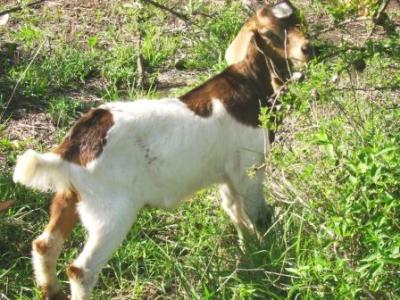
(c) Val Corr, Naivasha, Kenya
Categories of goats
Goats fall into four categories: meat, wool, dairy and dual (multi) purpose. Some goat breeds are dual purpose (e.g. meat and wool, or meat and milk). However, a majority of the current commercial breeds have been developed with specialization to one primary product in mind e.g., milk or dairy.
The meat breeds are produced from many goat breeds including milk goats. Some breeds have been selected specifically for meat production, such as the South African Boer and Galla and East African goats.
When selecting animals, it is important to think about the environment that they are to live in. Many pure bred animals come from Europe, where the climate is cool and good quality fodder plenty. These goats are not usually suited for hot dry areas with little available fodder.
Note: If you are buying milk goats, check the udders to ensure that there is good udder surface and that there are two good teats, and that the teats themselves are not too small. If the udder has small teats, they are very difficult to milk. On a good quality dairy goat the teats should be facing slightly forward for ease of milking.
Breeds such as the East African or the Galla goat have survived for centuries in East Africa with few problems and have good disease resistance. Farmers who want to improve their indigenous breeds by crossing their goats with exotic milk breeds must make sure they have enough good quality fodder and plenty of water available for drinking. Also improved housing for protection from predators and theft at night will help make the enterprise successful.
Meat Breeds
East African Goat
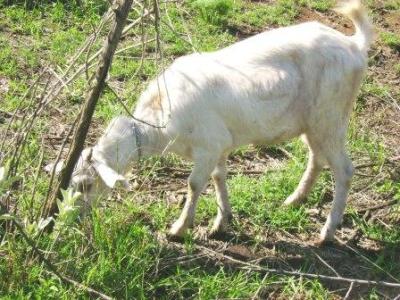
(c) Val Corr, Naivasha, Kenya
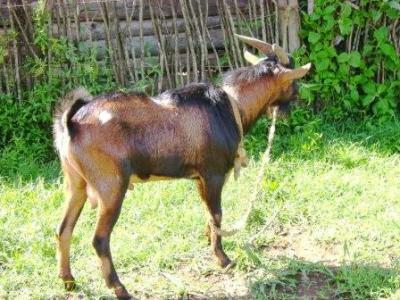
(c) Val Corr, Naivasha, Kenya
This is one of the most successful domestic goat breeds suitable for
the semi arid lands. They are found all over East Africa from the arid
areas to urban areas. Their colour ranges from pure white to black over a
variety of spotted and reddish brown colours. The males often have a
pronounced mane running the full length of the back. Horns vary from 2.5
cm to 20 cm long. Tassels (sometimes referred to as “toggles”, which
are situated at the top of the neck, behind the jaw) are found in 30% of
the breed.
Body weight: Males up to 35 kg, females 25-30 kg
Sexual maturity is usually reached in 5-6 months, but growth rate is slow. Yearlings seldom weigh more than 20 kg. The average age at first service ranges between 458 to 655 days with a kidding interval of 400 days. They have a kidding rate of 65% with a prolificacy of 0.95-1.10 meaning that they rarely twin. They have a birth weight of 3 kg and a weaning weight of 6.3 kg. They are kept mainly for their meat, as milk production usually is only enough for one single kid. They do have a potential for selection and are useful breeding stock for upgrading breeding. In their present unimproved form their greatest advantage is the ability to survive in almost any environment. Among the valuable characteristics of these goats is a tolerance to heartwater (an endemic tick-borne disease) and worms and possibly other diseases such as mange.
Galla Goat
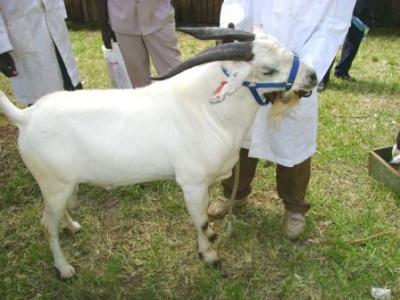
(c) Val Corr, Naivasha, Kenya
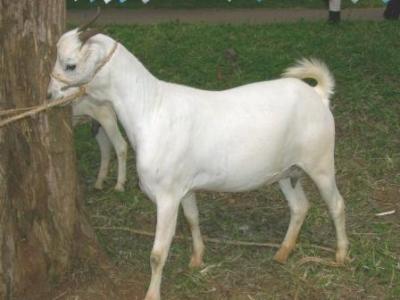
(c) Val Corr, Naivasha, Kenya
Galla are indigenous to the Northern areas of Kenya. It is also known as the Boran or the Somali goat. They have further been classified into 2 sub types, a short eared medium sized goat called “Degyir” and a larger pure white type called “Degeun”. Adult bucks of the Degeun type can weigh up to 70 kg, while a female will reach a kidded weight of 45-55 kg.
In order for the Galla goat to comply with the Kenya Stud book, all Gallas must be white haired with black skin, nose, feet and under tail.
A third sub type of Galla is kept by the Boran, which has colour around the head and lower legs with a black stripe down the spine. These are reputed to be the best milk yielders of all the Galla type goats. Galla females are long lived and will continue to breed and rear healthy kids up to 10 years of age.
Galla do not like cold wet climates and thrive best in low altitude, preferably in acacia bush country. They have a wonderful high growth rate after prolonged droughts and their larger size enables them to reach browse that the smaller East African goats cannot reach.
Boer
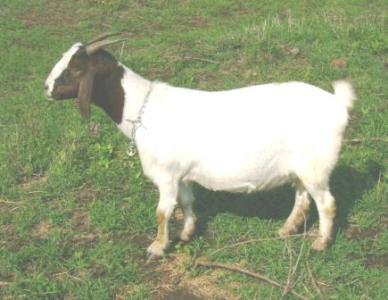
(c) Val Corr, Naivasha, Kenya

(c) A. Bruntse, Biovision
With its origins in South Africa, the Boer goats is a commercial goat with many things in its favour including early maturity, has high average growth and weaning weights, and are prolific non-seasonal breeders. Combined with a high dressing percentage, these goats can produce a good return for investment. Goats reach marketable size at approximately twelve to fourteen weeks of age depending on nutrition and management.
Doe kidding rates are between 120% and 180% however kidding percentages of over 200% are not uncommon. Does have a fertility cycle of between 18 and 21 days and a gestation period of 150 days. Further, since they are not seasonal breeders Boer goats are capable of producing three kiddings in two years under favourable conditions.
It is white with red/brown head and neck, has prominent horns and broad drooping ears. Well muscled and strong boned. They respond well to concentrate feeds. The breed is valued for its meat and milk. Milk yield, however, is relatively low, ca. 0.7 – 1 lit/day. Butter fat 6%.
Milk Breeds
Alpine
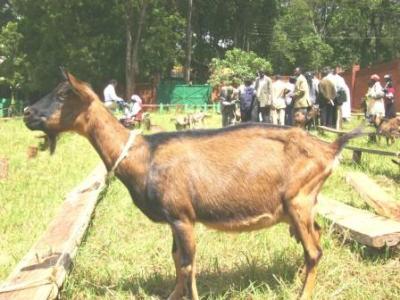
(c) Val Corr, Naivasha, Kenya
Kenya Alpine dairy goat (KADG) is a breed resulting from the grading-up of the local East African goat using pedigree German Alpine germplasm. This was and is still being done using natural service. The breed has four registration classes (genotypes) which include:
Table; Four registration classes of Kenya Alpine dairy goat
| Genetic Group | Percent German Alpine blood | Crosses |
| Foundation | 75% | Back cross 1 (R1): PAB x F1 Females |
| Intermediate | 87.5% | Back cross 2 (R2): PAB x F2 Females |
| Appendix | 93.75% | Back cross 3 (R3): PAB x R2 Female |
| Pedigree | >93.75% | Interse mating of Back cross 3: R2 Male x R2 Female. Offspring will remain 93.75% or more |
| OR | PAB x R2 Female –>Grading-up. Offspring will be 93.25% or more |
(c) Andrew G. Marete
Studies have shown that as the percent of pedigree blood increases, the goat becomes more prolific producing daily milk yield of 2.4 – 4.6 l when milked twice daily. Under proper management, the goat can come on heat at 8 months of age. However, the average age at first kidding is usually twice or more than this age. The goat comes to heat every 24 days with a gestation period of 150 days.
The KADG is the most promising small stock dairy breed in Kenya since it has been widely accepted in many Counties in Central, Eastern and Western regions; however maximal production is more dependent on the level of management as opposed to the genotype.KADG goat ears are pricked and the hair is long. The goat is medium size. Colour black and brown but considerable variations occur. Horns are scimitar shaped. The adult male weighs 65 kg, female 60 kg. The breed is valued for its milk and meat. Butterfat 3.6%.
Toggenburg
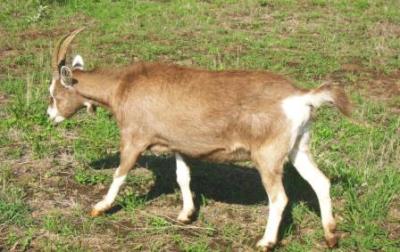
(c) Val Corr, Naivasha, Kenya
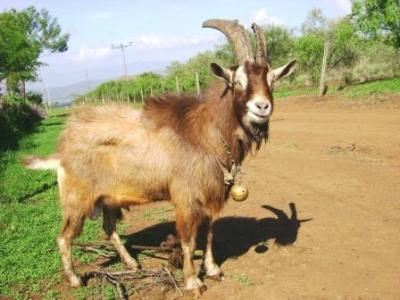
(c) Val Corr, Naivasha, Kenya
Kenya. It originated from Toggenburg in Switzerland. There are two sub-types of Toggenburg:
The British Toggenburg males weigh up to 100 kg and females about 70 kg.
The Swiss Toggenburg males weigh about 70 kg and the females about 50 kg.
They have an average birth weight of 3.3 kg with a weaning weight of 19 kg and average daily gain of 136 g/day. Studies have shown that the smallholder farmers are able to maintain comparably high levels of milk production in the first three parities, with yields of 475 – 520 l in the first, second and third parity respectively. The kidding interval has a range of 302+-117 days. Studies have demonstrated that the Toggenburg goats are able to perform and thrive reasonably well under the low-input farming conditions.
Colour: brown, chocolate, fawn with white line each side of the face from above the eyes to muzzle, edges of ears, on rump and tail. Legs white from knees down. Males tend to have longer hair than the female.
Suffer from heat stress in hot climates. Do not thrive if badly housed, kept on poor pasture or put away when they are wet. These are ‘high quality animals and should only be kept if conditions are right. For smaller farmers and, particularly, nil grazing situations, cross bred Toggenburgs would be a better option.
Purpose: milk production and cross breeding (improving local breeds). Butter fat 3.8%. Average litter size: 1.8
Saanen
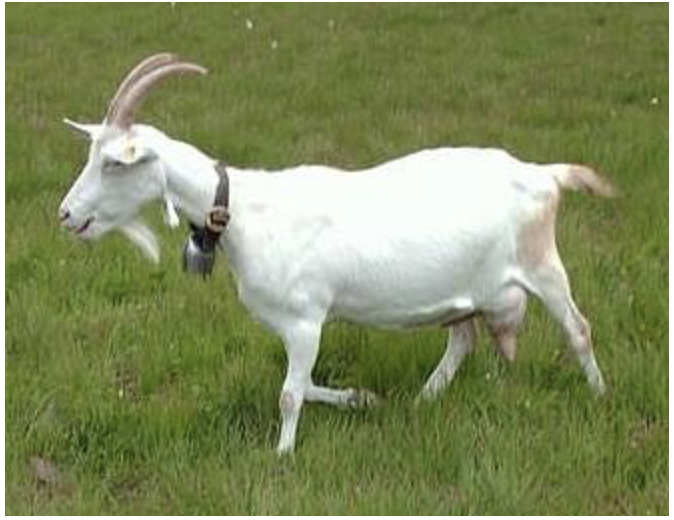
(c) Wikipedia
With its origin in West Switzerland, Saanens are the largest and one of the calmest of the dairy breeds. The Saanen breed also produces the most milk on average and tends to have lower butterfat content, about 2.5% – 3%. Estrous cycle length for Saanen goats is 21 days on average, while their average first mating age is 10 months. The age at their first use for breeding (kidding age) is 13 months. Estrous can be seen from 2-5 year olds. The breed is large and white/ biscuit in colour with black spots on nose, ears and udder and with pink skin pigmentation. Ears point forwards and upwards. The conformation is good and udders tend to be very well developed. Short coat. Mostly polled. Sometimes the kids are born with both male and female organs (Hermaphrodism). This is associated with the gene for polledness and it is advisable to only keep horned bucks for breeding. The face is straight and slightly dished. Does do not respond well to strong sunlight and in very hot areas performs best under shade. Mature male weighs 80-100 kg while mature female weighs 60-70 kg and the breed has a high twining rate. Saanen have outward curving horns. Purpose: milk production, up to 3-5 l of milk per day under good management. Butter fat 3.5%.
Dual purpose breeds
Unless under specialized management aimed at a defined production goal, most goat breeds are dual purpose breeds.
The Kenya Dual purpose goat (KDPG)
The KDPG is a synthetic breed resulting from a four way cross of mating two indeginous breeds and two exotic breeds, i.e. Galla X E.Agoat X Toggenburg X Anglo-Nubian. It is mainly used for both milk and meat, thus the name “dual purpose”. The KDPG produces a daily milk yield of about 1.1 kg with peak milk yield occuring on the 7th week after kidding. It constantly produces milk for 4 months. The cross breeds have high twinning rates and faster growth as well as larger body size than the local breeds.
The cross breeds fetch double the price compared to the local goats, due to larger body size and more kids due to high twinning rates. This introduction has led to much higher profits from goat rearing among the farmers undertaking this practice. (Personal communication from R. Muthama, Katumani farmer and Dr. Kariuki, Director, Katumani Research Station, Kenya).
Goats for wool fibre
Angora goat
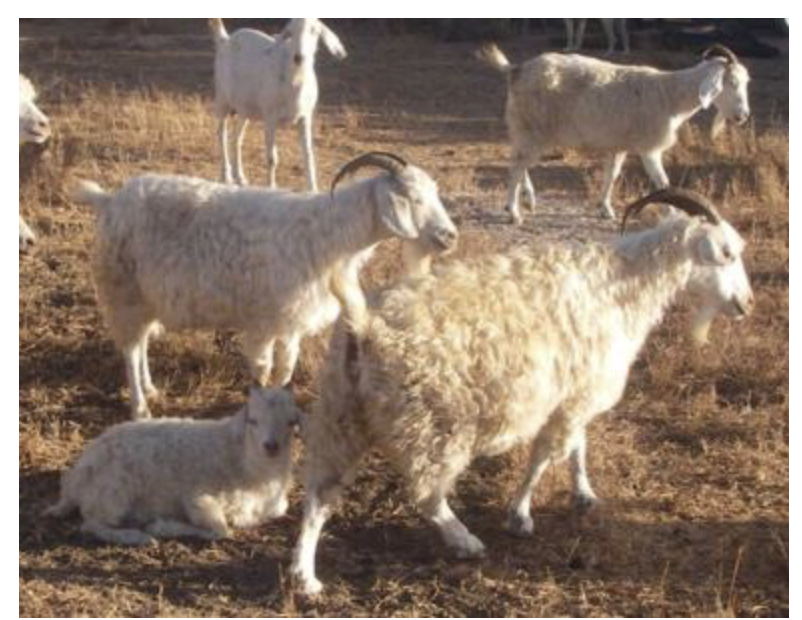
(c) Anne Bruntse, Biovision
Angoras are the most efficient fiber producing animals on earth, producing up to 25% of their own body weight in fiber annually. It is a small breed, usually white. The haircoat is long with undulating locks and ringlets of fine, silky hair. The top quality fleece of purebreds may be 1-2 lbs, but slightly more in males and wethers. They are bearded. Spring moult is natural and shearing occurs just before. They are not very prolific and twinning is less frequent than in other breeds. Angora goats are not raised for milk production but for fiber.Gestation is 145-150 days. Angoras breed seasonally, usually from August to January. Does are induced into estrus by the presence of a buck and cycle every 19-21 days until pregnant. A full grown buck in good condition can handle between 20 and 45 does; a kid buck will handle substantially fewer, probably no more than 10. When about to breed, the farmer should shear them and delouse and begin increasing their plane of nutrition several weeks in advance of breeding (called flushing). It is especially important that the buck is shorn particularly if it is hot. A shorn buck will be a more vigorous breeder and settle more does on the first attempt. It is also a good idea to worm and trim hooves a few weeks before breeding. Finally, Angora goats grow slowly and most do not reach their full body size until two years of age. For this reason, most does are bred for the first time as yearlings.